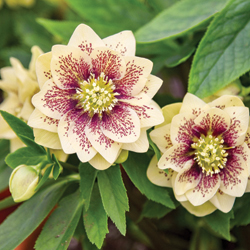March Plant of the Month: Hellebore, Harbinger of Spring
Submitted by Bath Gamma Garden Club
The Hellebore (helleborus ssp) is one of the earliest perennials to bloom and a sure sign that spring is here. Hellebores are also known as Lenten rose and Christmas rose. However, the rose-like blossoms they produce are not part of the rose family; they are part of the Ranunculaceae family.
Hybridizing has vastly improved the color range of the flowers, which extends from slate gray, near black, deep purple and plum to rich reds, pinks, yellow, white and green. Hellebore foliage is thick, leather-like evergreen and forms a low growing clump with leaves that are lobed and palm-like. They grow 1 to 2 feet in height and have a similar spread.
Hellebores are one of the easiest perennials to grow. They thrive in shady conditions where many plants struggle. They benefit from winter sunlight and protection from harsh winter winds. A good place to plant them is under deciduous trees where they will receive good winter sunlight. They do not like to be moved once established.
Hostas are great companion plants, as are daffodils, and the pairings can produce a terrific early garden in the spring. Hellebores require little maintenance. Cut winter worn foliage back to basal growth in late winter to early spring before flowering.
They grow best in well-drained soil that is rich in organic matter and has a neutral to alkaline PH balance. The best way to fertilize is by adding organic-rich fertilizer such as well-decayed manure or compost when planting and continue to apply a layer in spring and again in fall. Additional fertilizers are rarely needed. Consider adding lime if soil is too acidic. A soil test is recommended to determine soil PH.
Hellebores need moisture to get established. However, they do not like soggy soil and will rot if allowed to sit in wet soil for a prolonged period of time. Once established, they can tolerate drier conditions. Hellebores tolerate a wide range of humidity. Hardiness varies with species, but most are hardy USDA Zones 3-9. In colder climates, they benefit from winter protection.
The best way to ensure a specific color and variety is by purchasing potted nursery plants. Hellebores can be propagated by divisions, but this should be done in late winter as new growth appears and before they flower. Dig the entire plant and wash off the soil so you can see where the buds or eyes are. Make sure each division has two buds. When planting, the crown should be barely covered with the soil. As with peonies, planting too deeply inhibits flower production.
Most varieties reseed prolifically and form colonies of plants, but they will not be true to the original hybrid. They will resemble one of the parent species. These seedlings can be easily moved once large enough and have set their true leaves.
Hellebores are rarely troubled by diseases or pests, including deer. One common pest is aphids. Remove affected parts and spray with horticultural oil. On occasion, they can be affected with leaf spot or downy mildew but respond to treatment with fungicides.
Popular hybrids of Hellebores include ‘Anna’s Red,’ with rich red-purple blooms and leaves veined with pink; ‘Winter Jewels Amber Gem,’ with golden blossoms edged in pink; ‘New York Midnight,’ which blooms in shades of deep purple-black, jet black and purple grey that are punctuated with frilly, creamy glowing stamens; ‘Ivory Prince,’ which has outward facing ivory flowers painted with touches of rose and chartreuse; and the ‘Wedding Series’ with multiple varieties from which to choose. ∞

